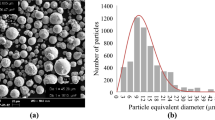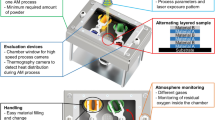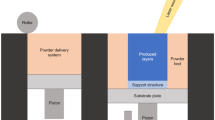Abstract
Multi-laser powder bed fusion (M-LPBF) systems, characterized by large building envelopes and multiple lasers, have become increasingly prevalent in industrial additive manufacturing. The increased build rate of these machines relative to single laser systems offers the potential to drastically reduce the cost per part. However, one major challenge with M-LPBF is that often multiple lasers are needed to build a single part. Therefore, the exposure area must be divided, and the segments must be assigned to different lasers. Various strategies for splitting the exposure area are available, but their influence on part quality remains yet to be determined. This study aims to investigate the impact of the fixed exposure border, variable exposure border, and segmented stripes M-LPBF exposure strategy on the part quality of samples built with two lasers compared to samples built with one laser. Therefore, the porosity, microstructure, and mechanical properties of IN718 samples were evaluated. The research shows that the fixed exposure border strategy resulted in a localized increase in porosity at the border or within the overlap area between segmented exposure areas, as well as grain coarsening and increased texture within the remelted areas. The variable exposure strategy also resulted in a higher porosity level, but the microstructure was more like the single laser reference sample. These changes resulted in a minor decrease in mechanical properties. The segmented stripes strategy exhibited a similar microstructure and mechanical properties to the single laser reference, making it the most suitable approach for M-LPBF in industrial applications.

























Similar content being viewed by others
References
Khorasani A, Gibson I, Veetil JK et al (2020) A review of technological improvements in laser-based powder bed fusion of metal printers. Int J Adv Manuf Technol 108:191–209. https://doi.org/10.1007/s00170-020-05361-3
Schwerz C, Schulz F, Natesan E et al (2022) Increasing productivity of laser powder bed fusion manufactured Hastelloy X through modification of process parameters. J Manuf Process 78:231–241. https://doi.org/10.1016/j.jmapro.2022.04.013
Sow MC, de TT, Castelnau O et al (2020) Influence of beam diameter on Laser Powder Bed Fusion (L-PBF) process. Addit Manuf 36:101532. https://doi.org/10.1016/j.addma.2020.101532
Cao L, Li J, Hu J et al (2021) Optimization of surface roughness and dimensional accuracy in LPBF additive manufacturing. Opt Laser Technol 142:107246. https://doi.org/10.1016/j.optlastec.2021.107246
Hanemann T (2022) Usability and limitations of dimensionless scaling laws in Laser Powder Bed Fusion. Karlsruher Institut für Technologie (KIT)
Wong H, Dawson K, Ravi GA et al (2019) Multi-laser powder bed fusion benchmarking—initial trials with Inconel 625. Int J Adv Manuf Technol 105:2891–2906. https://doi.org/10.1007/s00170-019-04417-3
Rott S, Ladewig A, Friedberger K et al (2020) Surface roughness in laser powder bed fusion – interdependency of surface orientation and laser incidence. Addit Manuf 36:101437. https://doi.org/10.1016/j.addma.2020.101437
Subramanian R, Rule D, Nazik O (2021) Dependence of LPBF surface roughness on laser incidence angle and component build orientation. In: Volume 7: Industrial and Cogeneration; Manufacturing Materials and Metallurgy. American Society of Mechanical Engineers
Fiegl T, Franke M, Körner C (2019) Impact of build envelope on the properties of additive manufactured parts from AlSi10Mg. Opt Laser Technol 111:51–57. https://doi.org/10.1016/j.optlastec.2018.08.050
Li F, Wang Z, Zeng X (2017) Microstructures and mechanical properties of Ti6Al4V alloy fabricated by multi-laser beam selective laser melting. Mater Lett 199:79–83. https://doi.org/10.1016/j.matlet.2017.04.050
Li S, Yang J, Wang Z (2021) Multi-laser powder bed fusion of Ti-6.5Al-2Zr-Mo-V alloy powder: defect formation mechanism and microstructural evolution. Powder Technol 384:100–111. https://doi.org/10.1016/j.powtec.2021.02.010
Yin J, Wang D, Wei H et al (2021) Dual-beam laser-matter interaction at overlap region during multi-laser powder bed fusion manufacturing. Addit Manuf 46:102178. https://doi.org/10.1016/j.addma.2021.102178
Zhang C, Zhu H, Hu Z et al (2019) A comparative study on single-laser and multi-laser selective laser melting AlSi10Mg: defects, microstructure and mechanical properties. Mater Sci Eng A 746:416–423. https://doi.org/10.1016/j.msea.2019.01.024
Li Z, Kuai Z, Bai P et al (2019) Microstructure and tensile properties of AlSi10Mg alloy manufactured by multi-laser beam selective laser melting (SLM). Metals 9:1337. https://doi.org/10.3390/met9121337
Wei K, Li F, Huang G et al (2021) Multi-laser powder bed fusion of Ti–6Al–4V alloy: defect, microstructure, and mechanical property of overlap region. Mater Sci Eng A 802:140644. https://doi.org/10.1016/j.msea.2020.140644
Bachmann F, Hielscher R, Schaeben H (2010) Texture analysis with MTEX – free and open source software toolbox. SSP 160:63–68. https://doi.org/10.4028/www.scientific.net/ssp.160.63
Cianciosi F, Buisson A-L, Tafforeau P et al (2021) BM18, the new ESRF-EBS beamline for hierarchical phase-contrast tomography. JACoW Publishing, Geneva, Switzerland
Ferreri NC, Vogel SC, Knezevic M (2020) Determining volume fractions of gamma, gamma′, gamma″, delta, and MC-carbide phases in Inconel 718 as a function of its processing history using an advanced neutron diffraction procedure. Mater Sci Eng A 781:139228. https://doi.org/10.1016/j.msea.2020.139228
Deng D, Peng RL, Brodin H et al (2018) Microstructure and mechanical properties of Inconel 718 produced by selective laser melting: sample orientation dependence and effects of post heat treatments. Mater Sci Eng A 713:294–306. https://doi.org/10.1016/j.msea.2017.12.043
Pant P, Salvemini F, Proper S et al (2022) A study of the influence of novel scan strategies on residual stress and microstructure of L-shaped LPBF IN718 samples. Mater Des 214:110386. https://doi.org/10.1016/j.matdes.2022.110386
Hilaire A, Andrieu E, Wu X (2019) High-temperature mechanical properties of alloy 718 produced by laser powder bed fusion with different processing parameters. Addit Manuf 26:147–160. https://doi.org/10.1016/j.addma.2019.01.012
Khairallah SA, Anderson AT, Rubenchik A et al (2016) Laser powder-bed fusion additive manufacturing: physics of complex melt flow and formation mechanisms of pores, spatter, and denudation zones. Acta Mater 108:36–45. https://doi.org/10.1016/j.actamat.2016.02.014
Volpp J, Belelli F, Casati R (2021) Fluctuations of tracks and layers during aluminium laser powder-bed fusion. Appl Sci 11:3132. https://doi.org/10.3390/app11073132
Popovich VA, Borisov EV, Popovich AA et al (2017) Functionally graded Inconel 718 processed by additive manufacturing: crystallographic texture, anisotropy of microstructure and mechanical properties. Mater Des 114:441–449. https://doi.org/10.1016/j.matdes.2016.10.075
Chlebus E, Gruber K, Kuźnicka B et al (2015) Effect of heat treatment on the microstructure and mechanical properties of Inconel 718 processed by selective laser melting. Mater Sci Eng A 639:647–655. https://doi.org/10.1016/j.msea.2015.05.035
Zhao J-R, Hung F-Y, Lui T-S (2020) Microstructure and tensile fracture behavior of three-stage heat treated inconel 718 alloy produced via laser powder bed fusion process. J Mater Res Technol 9:3357–3367. https://doi.org/10.1016/j.jmrt.2020.01.030
Gruber K, Stopyra W, Kobiela K et al (2022) Mechanical properties of Inconel 718 additively manufactured by laser powder bed fusion after industrial high-temperature heat treatment. J Manuf Process 73:642–659. https://doi.org/10.1016/j.jmapro.2021.11.053
Matthews MJ, Guss G, Khairallah SA et al (2016) Denudation of metal powder layers in laser powder bed fusion processes. Acta Mater 114:33–42. https://doi.org/10.1016/j.actamat.2016.05.017
Zhou J, Han X, Li H et al (2021) Investigation of layer-by-layer laser remelting to improve surface quality, microstructure, and mechanical properties of laser powder bed fused AlSi10Mg alloy. Mater Des 210:110092. https://doi.org/10.1016/j.matdes.2021.110092
Mancisidor AM, Garciandia F, Sebastian MS et al (2016) Reduction of the residual porosity in parts manufactured by selective laser melting using skywriting and high focus offset strategies. Phys Procedia 83:864–873. https://doi.org/10.1016/j.phpro.2016.08.090
Zhao C, Parab ND, Li X et al (2020) Critical instability at moving keyhole tip generates porosity in laser melting. Science 370:1080–1086. https://doi.org/10.1126/science.abd1587
Kan WH, Chiu LNS, Lim CVS et al (2022) A critical review on the effects of process-induced porosity on the mechanical properties of alloys fabricated by laser powder bed fusion. J Mater Sci 57:9818–9865. https://doi.org/10.1007/s10853-022-06990-7
Nadammal N, Cabeza S, Mishurova T et al (2017) Effect of hatch length on the development of microstructure, texture and residual stresses in selective laser melted superalloy Inconel 718. Mater Des 134:139–150. https://doi.org/10.1016/j.matdes.2017.08.049
Funding
This work was supported by the Federal Ministry of Education and Research Berlin, Germany (FKZ13N14996, 2019).
Author information
Authors and Affiliations
Contributions
The first draft of the manuscript was written by Tino Pfalz and all authors commented on previous versions of the manuscript. Material preparation, data collection, conceptualization, methodology, visualization, analysis, and investigation were performed by Tino Pfalz. Supervision was performed by Astrid Rota and Christoph Leyens and funding acquisition was performed by Astrid Rota. Part of the investigation was performed by Nazila Saeidnezhad. All authors read and approved the final manuscript.
Corresponding author
Ethics declarations
Competing interests
Tino Pfalz and Dr.-Ing. Astrid Rota are employed by EOS GmbH. EOS GmbH produces LPBF machines. Dr. Nazila Saeidnezhad is employed at Fraunhofer IIS.
Additional information
Publisher’s note
Springer Nature remains neutral with regard to jurisdictional claims in published maps and institutional affiliations.
Rights and permissions
Springer Nature or its licensor (e.g. a society or other partner) holds exclusive rights to this article under a publishing agreement with the author(s) or other rightsholder(s); author self-archiving of the accepted manuscript version of this article is solely governed by the terms of such publishing agreement and applicable law.
About this article
Cite this article
Pfalz, T., Rota, A., Saeidnezhad, N. et al. Comparison of different multi-laser powder bed fusion exposure strategies and their influence on the part quality of IN718. Int J Adv Manuf Technol 128, 4469–4490 (2023). https://doi.org/10.1007/s00170-023-12194-3
Received:
Accepted:
Published:
Issue Date:
DOI: https://doi.org/10.1007/s00170-023-12194-3




